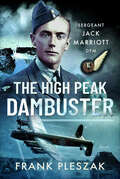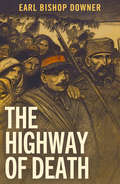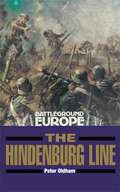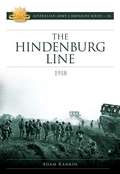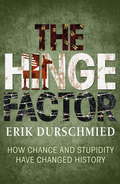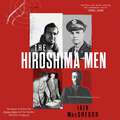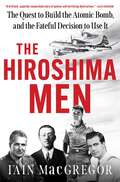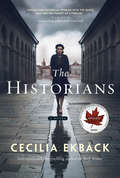- Table View
- List View
The High Ground: Leading in Peace and War
by R. D. Hooker"This is much more than a primer...readers will find numerous nuggets on the art and science of leadership that they can place in their kitbag." — Military ReviewThe High Ground draws on the author’s personal experiences as a combat leader to illustrate examples of successful and inspiring leadership in military organizations at all levels. Many of the essays contained in this volume focus on specific military personalities that portray effective leader behaviors in both peacetime and combat settings from the tactical to the strategic. Others describe key leadership characteristics and attributes of successful leaders, from small-unit level to the Pentagon. Throughout the author provides specific and compelling leadership advice and suggestions to new soldiers, new lieutenants, staff officers and commanders. The author served over thirty years in the post-Vietnam Army, rising from private to colonel and serving in the invasion of Grenada and in Somalia, the US response to the Rwandan genocide, in Bosnia and Kosovo, in peacekeeping operations in the Sinai, and in combat in Iraq and Afghanistan. He commanded a paratrooper company, battalion and brigade and served in the continental US, Latin America, Europe, the Middle East, Africa, and Southwest Asia. The High Ground describes his observations and interactions with military leaders at all levels, in battle and in garrison, to describe and portray military leader development and leader excellence in all its many and varied dimensions. Gripping and fast-paced, these leadership vignettes will carry the reader from peacetime into battle with the American Soldier.
The High Peak Dambuster: Sergeant Jack Marriott DFM
by Frank PleszakOperation Chastise, the audacious attack on the dams in the Ruhr valley, is arguably one of the most famous airborne attacks in history. During the night of 16/17 May 1943, 133 men in nineteen specially-adapted Lancasters – the famous Dambusters – set off to attack six dams deep in the heart of Germany. Eight of the bombers, and 56 of the aircrew, did not come home. Three of the aircrew who took part were from the High Peak region of Derbyshire. Flight Lieutenant Bill Astell, the pilot of ED864 who hailed from Coombs near Chapel-en-le-Frith, was killed after flying into electricity pylons on the way to the dams. The navigator in ED924, Sergeant John Nugent, from Stoney Middleton, survived the Dambusters Raid but was killed later in the war. The third High Peak Dambuster, on whom this biography concentrates, is the little-known Sergeant Jack Marriott from Chinley, the flight engineer on Lancaster ED937 during the attack. Marriott’s Lancaster, Z-Zebra, reached the Möhne Dam, only to discover that it had been breached, some five bouncing bombs already having been released at it. The crew, led by Squadron Leader Henry Maudslay DFC, then flew on to the Eder Dam where their ‘bouncing bomb’ exploded beneath the Lancaster after hitting the parapet of the structure. The damaged Lancaster struggled homeward, but was shot down on the Dutch border; Jack, together with his crew, was killed in the crash. In this autobiography, Frank Pleszak explores Jack’s life, his RAF service prior to joining 617 Squadron, and then the events leading up to and during Operation Chastise itself. But for Jack, one the immortal Dambusters, his story continued on after that historic night – particularly during the filming of the 1955 epic Dam Busters in which his aircraft features.
The High Road To Tokyo Bay — The AAF In The Asiatic-Pacific Theater [Illustrated Edition]
by Daniel HaulmanIncludes over 10 photos and mapsIn early 1942, Japanese military forces dominated a significant portion of the earth’s surface, stretching from the Indian Ocean to the Bering Sea and from Manchuria to the Coral Sea. Just three years later, Japan surrendered, having lost most of its vast domain. Coordinated action by Allied air, naval, and ground forces attained the victory. Air power, both land-and carrier-based, played a dominant role.Understanding the Army Air Forces’ role in the Asiatic-Pacific theater requires examining the context of Allied strategy, American air and naval operations, and ground campaigns. Without the surface conquests by soldiers and sailors, AAF fliers would have lacked bases close enough to enemy targets for effective raids. Yet, without Allied air power, these surface victories would have been impossible.The High Road to Tokyo Bay concentrates on the Army Air Forces’ tactical operations in Asia and the Pacific areas during World War II. A subsequent pamphlet will cover the strategic bombardment of Japan.
The Higher Frontier (Star Trek: The Original Series)
by Christopher L. BennettAn all-new Star Trek movie-era adventure featuring James T. Kirk! Investigating the massacre of a telepathic minority, Captain James T. Kirk and the crew of the U.S.S. Enterprise confront a terrifying new threat: faceless, armored hunters whose extradimensional technology makes them seemingly unstoppable. Kirk must team with the powerful telepath Miranda Jones and the enigmatic Medusans to take on these merciless killers in an epic battle that will reveal the true faces of both enemy and ally!
The Highland Battles: Warfare on Scotland's Northern Frontier in the Early Middle Ages
by Chris PeersThis in-depth history of medieval Scottish warfare highlights the rivalries between the Norse warlords and the early Scottish kings.Between the ninth and fourteenth centuries, Scotland’s northern and western highlands underwent a turbulent period of significant wars. The Highlands and islands were controlled by the kings of Norway or by Norse or Norse-Celtic warlords, who not only resisted Scottish royal authority but on occasion seemed likely to overthrow it.In The Highland Battles, Chris Peers provides a coherent and vivid account of the campaigns and battles that shaped Scotland. The narrative is structured around a number of battles—Skitten Moor, Torfness, Tankerness, Renfrew, Mam Garvia, Clairdon and Dalrigh—which illustrate phases of the conflict and reveal the strategies and tactics of the rival chieftains.Peers explores the international background to many of these conflicts which had consequences for Scotland’s relations with England, Ireland and continental Europe. He also considers to what extent the fighting methods of the time survived into the post-medieval period.
The Highland Furies
by Victoria SchofieldAs the oldest of the Highland Regiments, The Black Watch has an enviable roster of Battle Honours and a mystique born of repeated service on behalf of King, Queen and country. On the strength of her acclaimed biography of Field Marshal Earl Wavell, the regimental trustees commissioned Victoria Schofield to write this, the first volume of her magisterial history of the The Black Watch, and have fully cooperated with her as she traces the story of the Regiment from its early 18th-century beginnings through to the eve of the South African War at the end of the 19th-century. Originating as companies of highland men raised to keep a 'watch' over the Highlands of Scotland, they were formed into a regiment in 1739. Its soldiers would go on to fight with extraordinary bravery and élan in almost every major engagement fought by the British Army during this period, from the American War of Independence, the Peninsular Wars, Waterloo, the Crimea, Indian Mutiny to Egypt and the Sudan. Drawing on diaries, letters and memoirs, Victoria Schofield skilfully weaves the multiple strands of this story into an epic narrative of a valiant body of officers and men over one-and-a-half centuries. In her sure hands, the story of The Black Watch is no arid recitation of campaigns, dates and battle honours, but is instead a rich and compelling record of the soldier's experience under fire and on campaign. It is also a celebration of the deeds of a regiment that has played a unique role in British history and a vivid insight into the lives of the many remarkable figures who have marched and fought so proudly under its Colours.
The Highland Laird's Bride: A Marriage of Convenience in Medevial Scotland (Lovers and Legends #3)
by Nicole LockeAt the gates of a Scottish keep... Lioslath of Clan Fergusson has defended her clan and her orphaned siblings against countless enemies. So when Laird Colquhoun, the man responsible for the death of her father, arrives at the gates of her crumbling keep, she'll fight him all the way! It's soon clear Bram's famed tactics of seduction and negotiation won't work on this guarded, beautiful woman. But when the sparks between them turn to passion, and they're forced to wed, Bram must do whatever it takes to win over his new bride...
The Highway of Death
by Earl Bishop DownerThe Highway of Death, first published in 1916, is the chilling account of the Austro-Hungarian invasion of Serbia (a tragic, largely forgotten aspect of the First World War) as viewed by American Red Cross surgeon Earl Bishop Downer. Based in Belgrade, he describes the bitter back-and-forth fighting for control of this capitol city, the devastating artillery barrages, the doctors and nurses trying to treat the endless stream of wounded combatants, and a typhus epidemic that ravaged soldiers and civilians alike. Included are 34 pages of illustrations.
The Hijacked War: The Story of Chinese POWs in the Korean War
by David Cheng ChangThe Korean War lasted for three years, one month, and two days, but armistice talks occupied more than two of those years, as more than 14,000 Chinese prisoners of war refused to return to Communist China and demanded to go to Nationalist Taiwan, effectively hijacking the negotiations and thwarting the designs of world leaders at a pivotal moment in Cold War history. In The Hijacked War, David Cheng Chang vividly portrays the experiences of Chinese prisoners in the dark, cold, and damp tents of Koje and Cheju Islands in Korea and how their decisions derailed the high politics being conducted in the corridors of power in Washington, Moscow, and Beijing. Chang demonstrates how the Truman-Acheson administration's policies of voluntary repatriation and prisoner reindoctrination for psychological warfare purposes—the first overt and the second covert—had unintended consequences. The "success" of the reindoctrination program backfired when anti-Communist Chinese prisoners persuaded and coerced fellow POWs to renounce their homeland. Drawing on newly declassified archival materials from China, Taiwan, and the United States, and interviews with more than 80 surviving Chinese and North Korean prisoners of war, Chang depicts the struggle over prisoner repatriation that dominated the second half of the Korean War, from early 1952 to July 1953, in the prisoners' own words.
The Hill
by Leonard B. ScottTy is the grunt. Point man for his platoon. Jason is the favored one: a football hero picked for officer training school who leads his men into a slaughter ground from which most of them will never return. Ty and Jason -- Oklahoma brothers different in character, yet close in soul -- are about to meet in the Battle of Dak To, upon the blood-drenched sides of Hill 875.
The Hill Fights: The First Battle of Khe Sanh
by Edward F. MurphyWhile the seventy-seven-day siege of Khe Sanh in early 1968 remains one of the most highly publicized clashes of the Vietnam War, scant attention has been paid to the first battle of Khe Sanh, also known as "the Hill Fights." Although this harrowing combat in the spring of 1967 provided a grisly preview of the carnage to come at Khe Sanh, few are aware of the significance of the battles, or even their existence. For more than thirty years, virtually the only people who knew about the Hill Fights were the Marines who fought them. Now, for the first time, the full story has been pieced together by acclaimed Vietnam War historian Edward F. Murphy, whose definitive analysis admirably fills this significant gap in Vietnam War literature. Based on first-hand interviews and documentary research, Murphy's deeply informed narrative history is the only complete account of the battles, their origins, and their aftermath. The Marines at the isolated Khe Sanh Combat Base were tasked with monitoring the strategically vital Ho Chi Minh trail as it wound through the jungles in nearby Laos. Dominated by high hills on all sides, the combat base had to be screened on foot by the Marine infantrymen while crack, battle-hardened NVA units roamed at will through the high grass and set up elaborate defenses on steep, sun-baked overlooks. Murphy traces the bitter account of the U.S. Marines at Khe Sanh from the outset in 1966, revealing misguided decisions and strategies from above, and capturing the chain of hill battles in stark detail. But the Marines themselves supply the real grist of the story; it is their recollections that vividly re-create the atmosphere of desperation, bravery, and relentless horror that characterized their combat. Often outnumbered and outgunned by a hidden enemy--and with buddies lying dead or wounded beside them--these brave young Americans fought on. The story of the Marines at Khe Sanh in early 1967 is a microcosm of the Corps's entire Vietnam War and goes a long way toward explaining why their casualties in Vietnam exceeded, on a Marine-in-combat basis, even the tremendous losses the Leathernecks sustained during their ferocious Pacific island battles of World War II. The Hill Fights is a damning indictment of those responsible for the lives of these heroic Marines. Ultimately, the high command failed them, their tactics failed them, and their rifles failed them. Only the Marines themselves did not fail. Under fire, trapped in a hell of sudden death meted out by unseen enemies, they fought impossible odds with awesome courage and uncommon valor.
The Hills and the Valley (Hillsbridge Sagas)
by Janet TannerThe third evocative novel set in the mining town of Hillsbridge, perfect for fans of Sheila Newberry and Annie Groves Barbara Hall, pretty, mischievous, and seventeen, has grown up wanting for nothing. But a long-buried family secret is about to be uncovered and threaten her happiness. Will it deny her the one man she truly loves? And outside of the close-knit mining community of Hillsbridge, war once again looms on the horizon. Youngest of the Hall clan, fate is about to propel Barbara into maturity… The third spell-binding novel in the Hillsbridge Sagas will appeal to fans of Rosie Goodwin and Maggie Hope. ‘Sensitive and exceptionally polished’ Manchester Evening News The Hillsbridge Sagas 1 The Black Mountains 2 The Emerald Valley 3 The Hills and the Valley 4 A Family Affair
The Hills and the Valley (The Hillsbridge Sagas)
by Janet TannerShe grew up wanting for nothing—but war and a family secret could put an end to her dreams: &“This well-told story holds the reader&’s attention.&” —Publishers Weekly In the English coal mining town of Hillsbridge, Barbara Hall, pretty, mischievous, and seventeen, has grown up wanting for nothing. But a long-buried family secret is about to be uncovered and threaten her happiness. Will it deny her the one man she truly loves? Meanwhile, outside of the close-knit community, a world war once again looms on the horizon. For the youngest of the Hall clan, fate is about to propel Barbara into maturity . . .
The Hindenburg Line (Battleground Europe)
by Peter OldhamThe Hindenburg Line, or Siegfriedstellung, achieved almost mythical status in the minds of the British public: the strongest defence system the world had then seen, scientifically designed by fortification experts with only one aim, to keep at bay the British Army. So pleased and delighted were the British that church bells were rung when the Line was pierced at Cambrai in November 1917. The new wonder-weapon, the Tank, had shown itself to be capable of great deeds and British Generals were seen to be capable of showing the Germans what Tommy could do when properly organised. The initial elation was followed by disappointment as the Germans fought back and the Hindenburg defences were retaken when the Germans used "defence-in-depth" and "elastic-defence", both new concepts to the British who were to learn from their mistakes. The British were to witness triumph and joy again, when, towards the end of the Great War, the Hindenburg Line was to be broken by men from the Midlands.This book examines the reasons for the German's decision to fall back to a strong defence line while their Navy starved Britain into submission, and the "burnt earth" policy of devastation in the area evacuated. The design and layout of the Hindenburg Line, and the Battles for its possession in 1917 and 1918, are given: with numerous maps covering different sectors and the struggles for each village and farm, together with the part played by many British Regiments. The maps contain information on how to find all remaining vestiges of both German and British defences in the region, most of which are rarely visited and many of which have not been seen by British eyes for many years.No book since the Great War has examined this area in such detail, nor has any single account contained so much for the battlefield visitor to see. The sites of individual acts of bravery, including the winning of many Victoria Crosses are featured, and existing locations of battle lines, headquarters, artillery observation and machine gun posts are also included, together with an absorbing narrative which also guides the armchair reader.
The Hindenburg Line Campaign 1918 (Australian Army Campaigns #26)
by Adam RankinIn the last devastating months of the First World War, the British Fourth Army pursued the Germans to their final defensive position — the Hindenburg Line, a formidable series of defensive positions studded with concrete dugouts and thickly set barbed wire. The Hindenburg Line 1918 describes the two fiercely fought set-piece battles which saw Fourth Army break through the German line, paving the way for the final pursuit which ended with the Armistice. The Australian Corps was a pivotal part of the offensive to breach the Hindenburg Line, culminating in the assault to capture Montbrehain, the last Australian battle of the war. By the time it reached the Hindenburg Line, the Australian Corps had been in the line for months, its units exhausted and depleted. Despite this, these final offensives saw the battle-hardened Australians demonstrate their skill in the use of infantry, artillery, machine-guns, tanks, aeroplanes and all the other implements of war that had altered so fundamentally since 1914. Australian commanders had likewise benefited from years of war and were highly skilled in planning complex operations that incorporated the latest tactics, techniques and procedures. But the scale of operations on the Western Front required close cooperation with British and Allied troops, and it was as part of this coalition that the Australian Corps would play its vital role in finally securing battlefield victory and bringing the war to an end.
The Hinge Factor
by Erik DurschmiedFrom the wooden horse of Troy to the Gulf War, military history has been as much marked by chance and error, as by gallantry and heroism. Many conflicts have been decided by the caprice of weather, bad intelligence, heroism where it wasn't expected, or individual incompetence. In military terms, the incident that can swing a battle from victory to defeat in a moment is known as the Hinge Factor.THE HINGE FACTOR vividly describes battles which demonstrate this phenomenon - including the circumstances behind the loss of the Holy Cross, through to the attack of African war bees in 1914, to Star Wars weaponry described in the Gulf War. This enthralling book demystifies the general belief that battles are always won due to the brilliance of a general and will both inform and entertain a wide audience.
The Hinge Factor: How Chance and Stupidity Have Changed History
by Erik DurschmiedFrom the wooden horse of Troy to the Gulf War, military history has been as much marked by chance and error, as by gallantry and heroism. Many conflicts have been decided by the caprice of weather, bad intelligence, heroism where it wasn't expected, or individual incompetence. In military terms, the incident that can swing a battle from victory to defeat in a moment is known as the Hinge Factor.THE HINGE FACTOR vividly describes battles which demonstrate this phenomenon - including the circumstances behind the loss of the Holy Cross, through to the attack of African war bees in 1914, to Star Wars weaponry described in the Gulf War. This enthralling book demystifies the general belief that battles are always won due to the brilliance of a general and will both inform and entertain a wide audience.
The Hinge of Fate (Winston S. Churchill The Second World Wa #4)
by Winston S. ChurchillThe British prime minister recounts battles from Midway to Stalingrad, and how the Allies turned the tide of WWII: &“Superlative.&” —The New York Times The Hinge of Fate is the dramatic account of the Allies&’ changing fortunes. In the first half of the book, Winston Churchill describes the fearful period in which the Germans threaten to overwhelm the Red Army, Rommel dominates the war in the desert, and Singapore falls to the Japanese. In the span of just a few months, the Allies begin to turn the tide, achieving decisive victories at Midway and Guadalcanal, and repulsing the Germans at Stalingrad. As confidence builds, the Allies begin to gain ground against the Axis powers. This is the fourth in the six-volume account of World War II told from the unique viewpoint of the man who led his nation in the fight against tyranny. The series is enriched with extensive primary sources, as we are presented with not only Churchill&’s retrospective analysis of the war, but also memos, letters, orders, speeches, and telegrams, day-by-day accounts of reactions as the drama intensifies. Throughout these volumes, we listen as strategies and counterstrategies unfold in response to Hitler&’s conquest of Europe, planned invasion of England, and assault on Russia, in a mesmerizing account of the crucial decisions made as the fate of the world hangs in the balance. &“No memoirs by generals or politicians . . . are in the same class.&” —The New York Times
The Hinge of Fate: 1950 (Winston S. Churchill The Second World Wa #4)
by Winston S. ChurchillThe British prime minister recounts battles from Midway to Stalingrad, and how the Allies turned the tide of WWII: &“Superlative.&” —The New York Times The Hinge of Fate is the dramatic account of the Allies&’ changing fortunes. In the first half of the book, Winston Churchill describes the fearful period in which the Germans threaten to overwhelm the Red Army, Rommel dominates the war in the desert, and Singapore falls to the Japanese. In the span of just a few months, the Allies begin to turn the tide, achieving decisive victories at Midway and Guadalcanal, and repulsing the Germans at Stalingrad. As confidence builds, the Allies begin to gain ground against the Axis powers. This is the fourth in the six-volume account of World War II told from the unique viewpoint of the man who led his nation in the fight against tyranny. The series is enriched with extensive primary sources, as we are presented with not only Churchill&’s retrospective analysis of the war, but also memos, letters, orders, speeches, and telegrams, day-by-day accounts of reactions as the drama intensifies. Throughout these volumes, we listen as strategies and counterstrategies unfold in response to Hitler&’s conquest of Europe, planned invasion of England, and assault on Russia, in a mesmerizing account of the crucial decisions made as the fate of the world hangs in the balance. &“No memoirs by generals or politicians . . . are in the same class.&” —The New York Times
The Hinges of Battle: How Chance and Incompetence Have Changed the Face of History
by Erik DurschmiedThere is no shortage of stories when it comes to battles. Some were decided by genius, but many more by a quirk of fate, when that thin balance which separates success from disaster lay in a minor decision or a trivial incident that tipped the scales. The thrust of a spear, the blink of an eye, a single phrase or a misinterpreted command is all it takes. A moment of courage or cowardice, energy or weariness, resolution or indecision.Battles have shaped the course of history and decided the fate of mankind. From a brutal Attila the Hun who went down to defeat on the Catalaunian Fields, to an overbearing French artillery colonel at Dien Bien Phu; from the stout walls of Constantinople to a skimpy mealie-bag wall at Rorke's Drift; from the sun of Austerlitz to the snows of Stalingrad, it was always an incident that decided the outcome of battle.
The Hinges of Battle: How Chance and Incompetence Have Changed the Face of History
by Erik DurschmiedThere is no shortage of stories when it comes to battles. Some were decided by genius, but many more by a quirk of fate, when that thin balance which separates success from disaster lay in a minor decision or a trivial incident that tipped the scales. The thrust of a spear, the blink of an eye, a single phrase or a misinterpreted command is all it takes. A moment of courage or cowardice, energy or weariness, resolution or indecision.Battles have shaped the course of history and decided the fate of mankind. From a brutal Attila the Hun who went down to defeat on the Catalaunian Fields, to an overbearing French artillery colonel at Dien Bien Phu; from the stout walls of Constantinople to a skimpy mealie-bag wall at Rorke's Drift; from the sun of Austerlitz to the snows of Stalingrad, it was always an incident that decided the outcome of battle.
The Hiroshima Men: The Quest to Build the Atomic Bomb, and the Fateful Decision to Use It
by Iain MacGregor'Really outstanding' Jonathan DimblebyAt 8:15 a.m. on August 6th, 1945, the Japanese port city of Hiroshima was struck by the world's first atomic bomb. Built in the US by the top-secret Manhattan Project and delivered by a B-29 Superfortress, a revolutionary long-range bomber, the weapon destroyed large swaths of the city, instantly killing tens of thousands. The world would never be the same again.The Hiroshima Men's unique narrative recounts the decade-long journey towards this first atomic attack. It charts the race for nuclear technology before, and during the Second World War, as the allies fought the axis powers in Europe, North Africa, China, and across the vastness of the Pacific, and is seen through the experiences of several key characters: General Leslie Groves, leader of the Manhattan Project alongside Robert Oppenheimer; pioneering Army Air Force bomber pilot Colonel Paul Tibbets II; the mayor of Hiroshima, Senkichi Awaya, who would die alongside over eighty-thousand of his fellow citizens; and Pulitzer Prize-winning novelist John Hersey, who travelled to post-war Japan to expose the devastation the bomb had inflicted upon the city, and in a historic New Yorker article, described in unflinching detail the dangers posed by its deadly after-effect, radiation poisoning.This thrilling account takes the reader from the corridors of the White House to the laboratories and test sites of New Mexico; from the air war above Nazi Germany and the savage reconquest of the Pacific to the deadly firebombing air raids across the Japanese Home Islands. The Hiroshima Men also includes Japanese perspectives - a vital aspect often missing from Western narratives - to complete MacGregor's nuanced, deeply human account of the bombing's meaning and aftermath.
The Hiroshima Men: The Quest to Build the Atomic Bomb, and the Fateful Decision to Use It
by Iain MacGregorAn epic, riveting history based on new interviews and research that elucidates the approval, construction, and fateful decision to drop the atomic bomb on Hiroshima.At 8:15 a.m. on August 6, 1945, the Japanese port city of Hiroshima was struck by the world&’s first atomic bomb. Built in the US by the top-secret Manhattan Project and delivered by a B-29 Superfortress, a revolutionary long-range bomber, the weapon destroyed large swaths of the city, instantly killing tens of thousands. The world would never be the same. The Hiroshima Men&’s vivid narrative recounts the decade-long journey toward this first atomic attack. It charts the race for the bomb during World War II, as the Allies fought the Axis powers, and is told through several key characters: General Leslie Groves, leader of the Manhattan Project alongside Robert Oppenheimer; pioneering Army Air Force pilot Colonel Paul Tibbets Jr.; the mayor of Hiroshima, Senkichi Awaya, who would die alongside eighty thousand fellow citizens; and Pulitzer Prize–winning writer John Hersey, who traveled to Japan for the New Yorker to expose the devastation the bomb inflicted on the city and to describe in unflinching detail the dangers posed by radiation poisoning. This thrilling account takes the reader from the corridors of power in the White House and the Pentagon to the test sites of New Mexico; from the air war above Germany to the Potsdam Conference of Truman, Churchill, and Stalin; from the savage reconquest of the Pacific to the deadly firebombing air raids across Japan. The Hiroshima Men also includes Japanese perspectives—a vital aspect often missing from Western narratives—to complete Iain MacGregor&’s nuanced, deeply human account of the bombing&’s meaning and aftermath.
The Hiroshima Men: The Quest to Build the Atomic Bomb, and the Fateful Decision to Use It
by Iain MacGregor'Really outstanding' Jonathan DimblebyAt 8:15 a.m. on August 6th, 1945, the Japanese port city of Hiroshima was struck by the world's first atomic bomb. Built in the US by the top-secret Manhattan Project and delivered by a B-29 Superfortress, a revolutionary long-range bomber, the weapon destroyed large swaths of the city, instantly killing tens of thousands. The world would never be the same again.The Hiroshima Men's unique narrative recounts the decade-long journey towards this first atomic attack. It charts the race for nuclear technology before, and during the Second World War, as the allies fought the axis powers in Europe, North Africa, China, and across the vastness of the Pacific, and is seen through the experiences of several key characters: General Leslie Groves, leader of the Manhattan Project alongside Robert Oppenheimer; pioneering Army Air Force bomber pilot Colonel Paul Tibbets II; the mayor of Hiroshima, Senkichi Awaya, who would die alongside over eighty-thousand of his fellow citizens; and Pulitzer Prize-winning novelist John Hersey, who travelled to post-war Japan to expose the devastation the bomb had inflicted upon the city, and in a historic New Yorker article, described in unflinching detail the dangers posed by its deadly after-effect, radiation poisoning.This thrilling account takes the reader from the corridors of the White House to the laboratories and test sites of New Mexico; from the air war above Nazi Germany and the savage reconquest of the Pacific to the deadly firebombing air raids across the Japanese Home Islands. The Hiroshima Men also includes Japanese perspectives - a vital aspect often missing from Western narratives - to complete MacGregor's nuanced, deeply human account of the bombing's meaning and aftermath.
The Historians: A Novel
by Cecilia EkbäckThe Secret History meets Fatherland <P><P> Before the war they were the best of friends. Five brilliant young historians debated origins, ideas and the place of history in modern times under the guidance of the charismatic Professor Lindahl. When war broke out the five disbanded, ending up on different sides. Now one of them has been found tortured and killed . . . It is 1943 and Sweden’s neutrality in the war is under pressure. Laura Dahlgren, a bright young historian who is the right hand of the chief negotiator with Germany, is privy to ongoing discussions about the transport of German soldiers to occupied Norway and German access to Swedish iron ore. When her former best friend and fellow classmate, Britta, is discovered tortured and murdered, Laura is determined to find her killer. In the Swedish government, the secretary to the unpopular minister of foreign affairs, Jens Regnell, is sent Britta’s PhD thesis on Scandinavian supremacy without understanding why, just as he is becoming increasingly worried that his boss is secretly negotiating with the Reich without informing the government. In Lapland, near the iron mine, Sami are mysteriously disappearing. Taneli, a young Sami boy, decides to investigate after his sister suddenly goes missing. Together these three people will uncover a conspiracy that could topple their government and destroy their country’s identity—a conspiracy that others are desperate to contain at any cost necessary.

